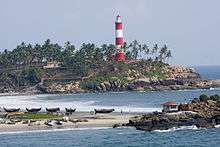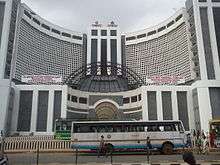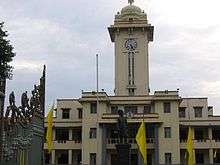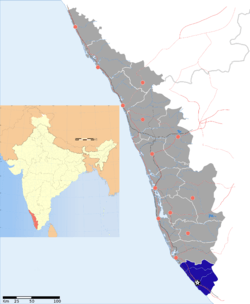Thiruvananthapuram
 [Full screen]
|
| Thiruvananthapuram തിരുവനന്തപുരം Trivandrum | ||
|---|---|---|
| Metropolis | ||
|
Clockwise from top right: Kovalam Beach, Napier Museum, Trivandrum Central, Kowdiar Palace, Niyamasabha Mandiram, Infosys Building, The Sculpture of Jalakanyaka Mermaid | ||
| ||
| Nickname(s): Evergreen city of India, Ananthapuri | ||
 Thiruvananthapuram  Thiruvananthapuram | ||
| Coordinates: 08°29′15″N 76°57′9″E / 8.48750°N 76.95250°ECoordinates: 08°29′15″N 76°57′9″E / 8.48750°N 76.95250°E | ||
| Country |
| |
| State | Kerala | |
| District | Thiruvananthapuram | |
| Founded by | Swathi Thirunal | |
| Government | ||
| • Body | Thiruvananthapuram Corporation | |
| • Mayor | V K Prasanth | |
| • Deputy Mayor | Rakhi Ravikumar | |
| • Police Commissioner | G Sparjan Kumar IPS[1] | |
| • Member of Parliament | Shashi Tharoor | |
| Area | ||
| • Metropolis | 214.86 km2 (82.96 sq mi) | |
| Area rank | 57 | |
| Elevation | 10 m (30 ft) | |
| Population (2011)[2] | ||
| • Metropolis | 957,730[3] | |
| • Rank | 14 | |
| • Density | 4,454/km2 (11,540/sq mi) | |
| • Metro[4] | 2,647,121 | |
| Languages | ||
| • Official language | Malayalam, English | |
| Time zone | IST (UTC+5:30) | |
| PIN | 695 XXX | |
| Telephone code | 0471 | |
| Vehicle registration | KL-01, KL-16, KL-19, KL-20, KL-21, KL- 22 | |
| Coastline | 78 kilometres (48 mi) | |
| Sex ratio | 1064[2] ♂/♀ | |
| Literacy | 97.72[2]% | |
| Planning agency | TRIDA | |
| Civic agency | Thiruvananthapuram Corporation | |
| Distance from Mumbai | 1,543 kilometres (959 mi) NW (land) | |
| Distance from Delhi | 2,884 kilometres (1,792 mi) N (land) | |
| Climate | Am/Aw (Köppen) | |
| Precipitation | 1,700 millimetres (67 in) | |
| Avg. annual temperature | 27.2 °C (81.0 °F) | |
| Avg. summer temperature | 35 °C (95 °F) | |
| Avg. winter temperature | 24.4 °C (75.9 °F) | |
| Website |
www | |
Thiruvananthapuram (Tiruvaṉantapuram, IPA: [t̪iruʋənən̪t̪əpurəm]), formerly known as Trivandrum, is the capital and the largest city of the Indian state of Kerala. It is located on the west coast of India near the extreme south of the mainland. Referred to by Mahatma Gandhi as the "evergreen city of India",[5][6] it is classified as a Tier-II city by the Government of India.
Thiruvananthapuram was a trading post for spices, sandalwood and ivory. The city was ruled by the Ays and was captured by the rulers of Venad in tenth century A.D. In 1729, Marthanda Varma founded the princely state of Thiruvithamkoor and made Thiruvananthapuram the capital in 1745. It remained as a princely state ruled by Travancore under the loose governance of the British before joining the Indian Union in 1948.
Thiruvananthapuram contributes nearly 80% of the state's software exports and is a major IT hub. It was ranked as the best city in Kerala to live in a 2012 survey by Times of India.[7] The city was also ranked as the best city in India for Housing and Transport by a survey conducted by India Today.[8][9]
Etymology
The city gets its name from Malayalam language word thiru-anantha-puram IPA: [t̪iruʋənən̪t̪əpurəm], meaning the "City of Lord Ananta."[10] The name derives from the deity of the Sri Padmanabhaswamy temple located in the city. Thiruvananthapuram is also known in literature and popular reference as Ananthapuri derived from Sanskrit and as Syanandurapuri, meaning "city of bliss" in Carnatic kirtanas composed by Swathi Thirunal, a Maharaja of Travancore.[11] The city was officially referred to as Trivandrum until 1991, when the government decided to reinstate the city's original name Thiruvananthapuram.
History

Thiruvananthapuram is an ancient region with trading traditions dating back to 1000 BCE.[12] The city was a trading post for spices, sandalwood and ivory.[13] The early rulers of the city were the Ays and after their fall in the 10th century, the city was captured by the rulers of Venad.[14]
In 1729, Marthanda Varma founded the princely state of Thiruvithamkoor and Thiruvananthapuram was made the capital in 1745 after shifting the capital from Padmanabhapuram in Tamil Nadu.[15] In the mid-19th century, the city was under the reign of Swathi Thirunal and Ayilyam Thirunal. An observatory was established in 1837 with the Oriental Research Institute & Manuscripts Library and the University College established in 1873. Several colleges were established by Moolam Thirunal (1885–1924).[14] Sree Moolam Assembly, established in 1904, was the first democratically elected legislative council in any Indian state.[16] Though the city was never under direct control of the British Empire, it featured in the Indian independence movement with a meeting of the Indian National Congress presided by Pattabhi Sitaramaiah held here in 1938.
After Indian Independence in 1947, Travancore chose to join the Indian union and the first ministry headed by Pattom Thanu Pillai was installed in office on 24 March 1948. In 1949, Thiruvananthapuram became the capital of Travancore-Cochin, the state formed by the integration of Travancore with the Kingdom of Cochin.[17] The king of Travancore, Chitra Thirunal Bala Rama Varma, became the Rajpramukh of the Travancore-Cochin Union from 1 July 1949 until 31 October 1956. When the state of Kerala was formed on 1 November 1956, Thiruvananthapuram became its capital.[18]
Demographics
The city has a population of 752,490 according to the 2011 census,[2] and 1,687,406 in the Urban Agglomeration.[4] The sex ratio is 1,032 females for every 1,000 males.[2] In October 2010, the number of wards was increased from 86 to 100 post expansion of city limits by adding Sreekaryam, Vattiyoorkavu, Kudappanakunnu, Vizhinjam and Kazhakuttam panchayats.[19][20]
Hindus comprise 68.5% of the population, Christians about 16.7% and Muslims form 13.7%.[21] The major languages spoken are Malayalam and English. The city is home to a prominent minority of Tamil speakers, owing to their migration from the adjoining district of Kanyakumari. The city also has a few Tulu, Konkani, Dhivehi, Hindi, Telugu, and Urdu speakers. As per 2001 census, the population below the poverty line in the city was 11,667 with majority living in slums and coastal fishing areas.[22]
Economy
The economy of the city is mainly based on the tertiary sector. Thiruvananthapuram was listed as one of the top 10 cites in India on Vibrancy and Consumption Index by a study conducted by global financial services firm Morgan Stanley.[23] The city is a major exporter of software with over 250 companies employing more than 40,000 professionals.[24][25] It contributes nearly 80% of the state's software exports.[26][27][28] Tourism also contributes to the economy of Thiruvananthapuram.[29][30][31] There are around 20 government owned and 60 privately owned medium and large-scale industrial units in Thiruvananthapuram. There are also about 30,000 small scale industrial units employing around 115,000 people. Traditional industries include handloom and coir.[32]
Administration
The state legislative assembly and Secretariat are located in Thiruvananthapuram. The city also serves as the headquarters of the Thiruvananthapuram district. The Thiruvananthapuram municipality was established in 1920 and was declared as a Corporation on 30 October 1940, during the rule of Chitra Thirunal Bala Rama Varma.[33] The city is administered by the Thiruvananthapuram Corporation which headed by a mayor and is responsible for the overall supervision and control of the administrative functions. The city elects its member of Parliament for the Thiruvananthapuram Lok Sabha constituency. It contributes four members to the legislative assembly from Kazhakuttam, Vattiyoorkavu, Thiruvananthapuram and Nemom.[34]
Geography and climate
Thiruvananthapuram is built on seven hills and is located at 8°30′N 76°54′E / 8.5°N 76.9°E on the west coast, near the southern tip of mainland India.[35] The city is bounded by Laccadive Sea to its west and the Western Ghats to its east. The city covers an area of 214.86 km2 (82.96 sq mi) and the average elevation is 16 ft (4.9 m) above sea level.[36][37] The Geological Survey of India has classified Thiruvananthapuram as a moderately earthquake-prone urban centre and categorised it in the Seismic III Zone.[38] Karamana and Killi rivers, Vellayani and Akkulam lakes are the main water bodies in the city.[39]
The city has a climate that borders between a tropical savanna climate and a tropical monsoon climate. The humidity is high and is the highest during the monsoon season.[40] Thiruvananthapuram gets majority of the rain from the south-west monsoons and gets its first showers in early June. It also gets rain from the receding north-east monsoons in October. The lowest temperature in the city core recorded during winter was 16.4 °C on, and the highest temperature recorded in summer is 38.0 °C.[41]
| Climate data for Thiruvananthapuram City (1971–2000) | |||||||||||||
|---|---|---|---|---|---|---|---|---|---|---|---|---|---|
| Month | Jan | Feb | Mar | Apr | May | Jun | Jul | Aug | Sep | Oct | Nov | Dec | Year |
| Record high °C (°F) | 35.5 (95.9) |
36.3 (97.3) |
37.7 (99.9) |
38.0 (100.4) |
35.8 (96.4) |
35.8 (96.4) |
33.7 (92.7) |
34.0 (93.2) |
35.4 (95.7) |
35.0 (95) |
34.3 (93.7) |
35.5 (95.9) |
38.0 (100.4) |
| Average high °C (°F) | 32.0 (89.6) |
32.3 (90.1) |
33.2 (91.8) |
33.1 (91.6) |
32.3 (90.1) |
30.1 (86.2) |
29.8 (85.6) |
29.8 (85.6) |
30.6 (87.1) |
30.4 (86.7) |
30.6 (87.1) |
31.6 (88.9) |
31.3 (88.3) |
| Average low °C (°F) | 22.1 (71.8) |
22.8 (73) |
24.1 (75.4) |
25.1 (77.2) |
25.0 (77) |
23.7 (74.7) |
23.2 (73.8) |
23.2 (73.8) |
23.5 (74.3) |
23.3 (73.9) |
23.2 (73.8) |
22.7 (72.9) |
23.5 (74.3) |
| Record low °C (°F) | 16.4 (61.5) |
18.1 (64.6) |
20.2 (68.4) |
20.3 (68.5) |
20.1 (68.2) |
20.0 (68) |
20.2 (68.4) |
18.2 (64.8) |
20.8 (69.4) |
20.1 (68.2) |
18.9 (66) |
18.2 (64.8) |
16.4 (61.5) |
| Average precipitation mm (inches) | 15.9 (0.626) |
22.7 (0.894) |
27.8 (1.094) |
118.8 (4.677) |
198.6 (7.819) |
330.4 (13.008) |
188.1 (7.406) |
152.3 (5.996) |
169.1 (6.657) |
254.5 (10.02) |
211.9 (8.343) |
64.0 (2.52) |
1,754.2 (69.063) |
| Average precipitation days | 1.0 | 1.7 | 2.3 | 6.5 | 9.7 | 16.6 | 13.4 | 10.3 | 8.7 | 11.7 | 9.2 | 4.2 | 95.4 |
| Average relative humidity (%) | 69 | 70 | 72 | 77 | 79 | 85 | 84 | 83 | 82 | 83 | 82 | 74 | 78 |
| Mean monthly sunshine hours | 262.8 | 242.3 | 250.7 | 214.0 | 197.3 | 133.5 | 149.7 | 166.6 | 173.4 | 170.8 | 166.3 | 216.6 | 2,344 |
| Source #1: India Meteorological Department (record high and low up to 2010)[41][42] | |||||||||||||
| Source #2: NOAA (sun and humidity, 1971–1990)[43] | |||||||||||||
Infrastructure
Electricity services are provided by Kerala State Electricity Board (KSEB).[44] Peppara and Aruvikkara dams are the main sources of water for the city and a new project plan for improving the water supply with Japanese aid was launched in 2011.[44] The sewage is disposed at the Muttathara Sewage Treatment Plant, which handles 32 million liters per day. The city area is divided into seven blocks for the execution of the sewage system, two commissioned in the 1990s and two after 2000. The sewerage was pumped to a stilling chamber at the Sewerage Treatment Plant (STP) at Valiyathura and is disposed through sewage farms.[45]

Tourism
Thiruvananthapuram is a popular destination for tourists. Kovalam is a popular beach town located 16 kilometres (9.9 mi) from the city. The Padmanabhaswamy Temple circled by the East Fort is amongst the richest temples in India.[46] Other places of interest include Sanghumukham Beach, Napier museum and Zoo, Agasthyarkoodam peak, Neyyar Wildlife Sanctuary and Neyyar Dam, Kuthira Malika palace, Ponmudi, Poovar, Varkala Cliffs and Edava lake.
Transport

The NH 544 connects the city with Salem and Kanyakumari in Tamil Nadu. The Main Central Road is an arterial road in the city and is designated as State Highway 1. Thiruvananthapuram Central is the major railway station serving the city. It falls under the Southern Railway zone of the Indian Railways and the Kollam-Thiruvananthapuram trunk line connects the city with the rail network. There are five railway stations in the city namely, the Thiruvananthapuram central, Thiruvananthapuram Pettah, Kochuveli, Veli and Nemom.[47]
Thiruvananthapuram is served by the Thiruvananthapuram International Airport. It has direct connectivity to the Middle East, Malaysia, Singapore, Maldives and Sri Lanka, being one of the gateways to the state. The airport is qualified for all-weather and night operations.[48] The airport is 3.7 kilometres (2.3 mi) from the central business district.[49] It is the headquarters of the Southern Air Command (SAC) of the Indian Air Force.[50]
Culture
The rulers of erstwhile Travancore took an active interest in the development of arts. Thiruvananthapuram has produced artists like Maharaja Swathi Thirunal, Irayimman Thampi and Raja Ravi Varma.[51]
Education

Thiruvananthapuram is an educational hub. There are about 15 engineering colleges, three medical colleges, three Ayurveda colleges, two homoeopathy colleges, six other medicine related colleges, 1 agricultural college, two of the management institutions and two law colleges in the city and its suburbs.[52] Major institutions include the University of Kerala, Trivandrum Medical College, Indian Institute of Space Science and Technology, Indian Institute of Science Education and Research, Thiruvananthapuram, Indira Gandhi National Open University, College of Engineering, Government Engineering College, Sree Chitra Thirunal College of Engineering and . Centre for Development Studies and Centre for Development of Imaging Technology are research institutions located in the city.
Media
Daily newspapers are available in English, Malayalam and Tamil. The English newspapers with editions from Thiruvananthapuram are The New Indian Express, The Hindu, The Deccan Chronicle and The Times of India. The major Malayalam newspapers are Mathrubhumi, Malayala Manorama, Kerala Kaumudi, Deshabhimani, Madhyamam, Janmabhumi, Chandrika, Thejas, Siraj, Deepika and Rashtra Deepika. The government-owned Doordarshan began broadcasting in 1981. Asianet, the first private Malayalam channel, began its telecasts in 1991. The other channels based in Thiruvananthapuram include Amrita TV, Kairali TV, Kairali We, Mathrubhumi News, Kaumudy TV, JaiHind TV, Asianet News, Asianet Movies, Asianet Plus and People TV. The local cable services are provided by Asianet Digital and other local service providers apart from DTH services.
Sports
Popular games include Football and Cricket.[53] Basketball, Badminton and Volleyball are played in schools. Kerala Cricket Association is headquartered in Thiruvananthapuram. The city has a multi-functional stadium at Karyavattom and a shooting range at Vattiyoorkkavu.
Notable people
Sister cities
Trivandrum has Galveston as it's sister city, as designated by Sister Cities International:[54]
References
- ↑ "Sparjan Kumar is new commissioner". Times of India. 24 January 2016. Retrieved 5 August 2016.
- 1 2 3 4 5 Provisional Population Totals, Census of India 2011; Cities having population 2 lakh and above (PDF) (Report). Office of the Registrar General & Census Commissioner, India. Retrieved 26 March 2012.
- ↑ "General Information". Thiruvananthapuram Corporation. Retrieved 5 August 2016.
- 1 2 Provisional Population Totals, Census of India 2011; Urban Agglomerations/Cities having population 2 lakh and above (PDF) (Report). Office of the Registrar General & Census Commissioner, India. Retrieved 26 March 2012.
- ↑ "Thiruvananthapuram India". Destination 360. Retrieved 18 June 2010.
- ↑ "Evergreencity of India".
- ↑ "Thiruvananthapuram best Kerala city to live in: Times survey". The Times of India. Retrieved 5 August 2016.
- ↑ "India's Best Cities: Winners and Why they made it". India Today. 22 February 2013. Retrieved 27 March 2013.
- ↑ "Chennai bags top honour at India Today best city awards". Daily Mail. 22 February 2013. Retrieved 27 March 2013.
- ↑ "About Thiruvananthapuram". Thiruvananthapuram Municipal Corporation. Retrieved 29 October 2010.
- ↑ "Swati manuscripts found". The Hindu. Retrieved 3 August 2016.
- ↑ Henry, James (1977). The Jews in India and the Far East. Greenwood Press Reprint. ISBN 978-0837-126-15-9.
- ↑ "Ancient Trade in Thiruvananthapuram". Technopark Kerala. Archived from the original on 3 October 2006. Retrieved 17 October 2006.
- 1 2 "History of Thiruvananthapuram". Government of Kerala. Retrieved 23 May 2006.
- ↑ "District Profile". About Thiruvananthapuram. National Informatics Centre District Centre, and Content Management Team Collectorate Thiruvananthapuram. Retrieved 22 May 2010.
- ↑ "History of legislative bodies in Keralan". History of legislative bodies in Kerala - Sri Mulam Popular Assembly. Kerala Assembly. Retrieved 10 October 2010.
- ↑ Menon, Madhava (2005). Criminal Justice India Series: Kerala. Allied Publishers. p. 5. ISBN 978-8177-643-91-6.
- ↑ "Kerala at a glance". Govt of Kerala. Retrieved 6 October 2010.
- ↑ "LDF, BJP hit the poll trail early in State capital". The Hindu. 4 October 2010. Retrieved 8 February 2011.
- ↑ "Kerala: Addition of wards". The Hindu. 16 June 2010. Retrieved 8 February 2011.
- ↑ Religious census 2011. Government of India (Report). Retrieved 7 August 2016.
- ↑ Study of urban poor in TMC area (PDF). JNNURM (Report). Archived from the original (PDF) on 27 January 2011. Retrieved 9 November 2010.
- ↑ AlphaWise City Vibrancy Index: A Guide to India’s Urbanization (PDF). Morgan Stanley (Report). p. 7. Retrieved 24 April 2011.
- ↑ "IT companies in Technopark". Technopark. Retrieved 24 March 2011.
- ↑ "Technopark – Harmont at work". Department of IT, Government of Kerala. Retrieved 28 June 2010.
- ↑ Exports from companies in Technopark: Chapter 21, page:502, section:21.8 (PDF) (Report). Planning Board, Government of Kerala. 1 December 2009. Retrieved 22 October 2010.
- ↑ "India's hottest IT destinations". Rediff. Retrieved 22 October 2010.
- ↑ Exports from companies in Technopark: Chapter 21, page:220, section:21.66 (PDF) (Report). Planning Board, Government of Kerala. 1 December 2010. Retrieved 28 February 2011.
- ↑ Tourism statistics 2007 (PDF). Tourism Department, Kerala (Report). Retrieved 8 May 2008.
- ↑ "=Tourism statistics 2005" (PDF). Tourism Department, Kerala. Archived from the original (PDF) on 21 September 2006. Retrieved 2 October 2006.
- ↑ Destination wise foreign tourist visits (PDF). Kerala Tourism (Report). Retrieved 4 August 2016.
- ↑ "Statistical data". Government of Kerala. Retrieved 25 August 2006.
- ↑ "Thiruvananthapuram Municipal Corporation". Thiruvananthapuram Municipal Corporation Introduction. Retrieved 3 January 2011.
- ↑ Delimitation of Assembly Constituencies, Final Order (PDF) (Report). Chief Electoral Officer, Kerala. Retrieved 3 March 2011.
- ↑ Abram, David (2005). South India. Rough Guides. p. 261. ISBN 978-1843-531-03-6.
- ↑ "Details of Municipalities (Grade wise)". Details of Municipalities. Department of Urban affairs, Government of Kerala. Retrieved 3 January 2011.
- ↑ "Rainfall Stations in India". Indian Institute of Tropical Meteorology. Retrieved 18 June 2010.
- ↑ Seismic zoning map of India (Map). Geological Survey of India. Retrieved 1 July 2010.
- ↑ Kapoor, Subodh (2002). The Indian encyclopaedia. Genesis publishing. ISBN 978-8177-552-57-7.
- ↑ "Thiruvananthapuram Climate". Weatherbase. Retrieved 25 August 2006.
- 1 2 "Ever recorded Maximum and minimum temperatures upto 2010". India Meteorological Department. Archived from the original (PDF) on 21 May 2013. Retrieved 25 October 2014.
- ↑ "Thiruvananthapuram Climatological Table Period: 1971-2000". India Meteorological Department. Retrieved 25 October 2014.
- ↑ "Thiruvananthapuram Climate Normals 1971-1990". National Oceanic and Atmospheric Administration. Retrieved 25 October 2014.
- 1 2 "Infrastructure in Thiruvananthapuram". Government of Kerala. Retrieved 8 March 2011.
- ↑ "Thiruvananthapuram Sewage Scheme". Government of Kerala. Retrieved 16 October 2006.
- ↑ "Temples' riches". The Economist. February 2013. Retrieved 5 August 2016.
- ↑ "Railway Stations in Thiruvananthapuram, Kerala". India rail info. Retrieved 12 October 2010.
- ↑ "Plea for AIE headquarters in Thiruvananthapuram". The Hindu. 12 November 2010. Retrieved 12 April 2011.
- ↑ "Thiruvananthapuram Airport General Information". Airports Authority of India. Retrieved 5 December 2010.
- ↑ "Air Commands in India". Indian Air Force. Retrieved 29 August 2006.
- ↑ "Life of HH Swathi Thirunal". Swathi Thirunal's life. swathithirunal. Retrieved 25 August 2006.
- ↑ "Technical Education in Kerala – Department of Technical education". Government of Kerala. Retrieved 25 August 2006.
- ↑ "Football and Cricket – the Most Popular Games". Information and Public relations office of Kerala. Retrieved 12 June 2006.
- ↑ http://www.asiamattersforamerica.org/india/data/sistercities. Missing or empty
|title=(help)
External links
- Official District website
- Public Relations Department Page on Thiruvananthapuram
- Government of Kerala Website on Thiruvananthapuram District


